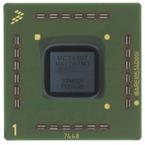●Overview
●The MPC7448 processor represents the most significant product update in the MPC74xx line of processors to date. The MPC7448 is the first high-performance processor manufactured on 90 nanometer silicon-on-insulator (SOI) process technology and continues our strong legacy of providing Power Architecture products with extensive processing performance at very low power. The MPC7448 is designed to perform between 600 MHz and in excess of 1.5 GHz, contains a full megabyte of L2 cache and offers enhanced power management capabilities. MPC7448 processors are ideal for leading-edge pervasive computing, embedded network control and signal processing applications.
●AltiVec® Engine Acceleration
●The MPC7448 includes the same powerful 128-bit AltiVec vector execution unit as found in previous MPC74xx devices, but with the enhanced support for out-of-order instructions. AltiVec technology may dramatically enhance the performance of applications such as voice over IP, speech recognition, multi-channel modems, virtual private network servers, high-resolution 3D graphics, motion video (MPEG®2, MPEG4), high fidelity audio (3D audio, AC-3), and so on.
●AltiVec computational instructions are executed in the four independent, pipelined AltiVec execution units. A maximum of two AltiVec instructions can be issued in order to any combination of AltiVec execution units per clock cycle. In the MPC7448, a maximum of two AltiVec instructions can be issued out-of-order to any combination of AltiVec execution units per clock cycle from the bottom two AltiVec instruction queue entries. For example, an instruction in queue 1 destined for AltiVec integer unit 1 does not have to wait for an instruction in queue 0 that is stalled behind an instruction waiting for operand availability.
●Power Management
●Continuing to pursue lower and lower power consumption is a keen focus with the NXP® family of Power Archtitecture processors, and the MPC7448 is no exception. Power management features include:
● Expanded Dynamic Frequency Switching (DFS) enabling software to change power consumption
● Nap and Sleep modes
● Voltage scaling down to at least 1.0 volt
● Added benefits of 90-nm technology:
● Multi-Vt and Triple Gate Oxide integrated transistors for low standby power
● Low-K Dielectric for high performance with reduced power and noise
● Temperature sensing diodes included to monitor die temperature
●MoreLessComparison Table
●### Specification Comparison
●| MPC7447 | MPC7447A | MPC7448
●\---|---|---|---
●Reliability
● | 10 yrs at 105°C | 10 yrs at 105°C | 10 yrs at 105°C
●Technology
● | 130 nm silicon-on-insulator (SOI) | 130 nm silicon-on-insulator (SOI) | 90nm silicon-on-insulator (SOI)
●Package
● | 360 ball HiTCE BGA | RoHS-compliant 360 ball HiTCE BGA or LGA | RoHS-compliant 360 ball HiTCE BGA or LGA
●MPX Bus Speeds
● | 133 and 167 MHz | 133 and 167 MHz | 133, 167 and 200MHz
●Caches (per core)
● | L1: 32kB I/D
●L2: 512 KB | L1: 32kB I/D
●L2: 512 KB | L1: 32kB I/D
●L2: 1MB with ECC
●Processor
● | Single G4 P core 600-1267 MHz 2.3 MIPS/MHz | Single G4 core 600-1420 MHz 2.3 MIPS/MHz | Single e600 core 600MHz -1.7GHz 2.3 MIPS/MHz
●Voltage
● | 1.1V and 1.3V | 1.1V and 1.3V | 1.0V to 1.3V
●18.3W @1267 MHz
● | 18.3W @1267 MHz | 21W @ 1420 MHz | <15W @ >1.5 GHz
●8.3W @1000 MHz
● | 8.3W @1000 MHz | 9.2W @ 1167 MHz | <10W @ >1.0 GHz
● NOTE:
●The e600 core is virtually identical to the G4 core, but with enhancements to L2 cache and AltiVec implementation, and it is manufactured in 90nm technology. Software written for the MPC7447 and MPC7447A will run seamlessly on the MPC7448. MPC7448 can be a pin-for-pin compatible drop-in replacement for MPC7447A.

 Part 3D Model
Part 3D Model
